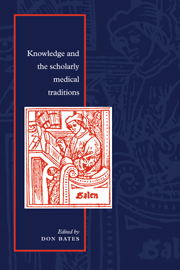Book contents
- Frontmatter
- Contents
- List of illustrations
- List of contributors
- Acknowledgements
- 1 Scholarly ways of knowing: an introduction
- Part 1 Scholarly medicine in the West
- Part 2 Chinese traditional medicine
- 9 Text and experience in classical Chinese medicine
- 10 Visual knowledge in classical Chinese medicine
- 11 A deathly disorder: understanding women's health in late imperial China
- 12 Re-writing traditional medicine in post-Maoist China
- Part 3 Āyurvedic medicine
- Part 4 Commentaries
- Index
11 - A deathly disorder: understanding women's health in late imperial China
Published online by Cambridge University Press: 01 February 2010
- Frontmatter
- Contents
- List of illustrations
- List of contributors
- Acknowledgements
- 1 Scholarly ways of knowing: an introduction
- Part 1 Scholarly medicine in the West
- Part 2 Chinese traditional medicine
- 9 Text and experience in classical Chinese medicine
- 10 Visual knowledge in classical Chinese medicine
- 11 A deathly disorder: understanding women's health in late imperial China
- 12 Re-writing traditional medicine in post-Maoist China
- Part 3 Āyurvedic medicine
- Part 4 Commentaries
- Index
Summary
The subject of this paper is how physicians in late imperial China (c. 1500–1850) understood women's bodies and health problems. Two questions raised in this paper relate closely to issues explored by Lesley Dean-Jones. First, did orthodox Chinese physicians, all of whom were men, feel any uncertainty about their knowledge of the female body? And second, what value did they place on women's testimony about their bodily states and experiences? In the third part of the paper I look at patterns of medical reasoning and choices of diagnosis in the case of a single, sex-specific health problem, amenorrhoea, which physicians and lay people alike thought of as life-threatening. The late imperial gynaecological texts on amenorrhoea offer interesting insights into levels of medical causality, the relationship between professional and lay reasoning, and the power of words to influence therapeutic choice.
Knowing the other sex
Orthodox physicians in late imperial China included literati and hereditary physicians. The literati doctors were also well trained as scholars and more deeply versed in general philosophy than the hereditary physicians, but both groups had studied the medical canonical texts and shared a cosmological understanding of the nature of the human body and its disorders. These physicians were exclusively male. Did they, like certain Greek physicians, have any doubts as to their understanding of the female body?
Such uncertainty clearly relates to how the physical difference between the sexes was understood. In the Greek medical tradition, the explanation of sex differences centred mainly on a contrast in reproductive form and function from which other secondary differences derived.
- Type
- Chapter
- Information
- Knowledge and the Scholarly Medical Traditions , pp. 235 - 250Publisher: Cambridge University PressPrint publication year: 1995
- 1
- Cited by



